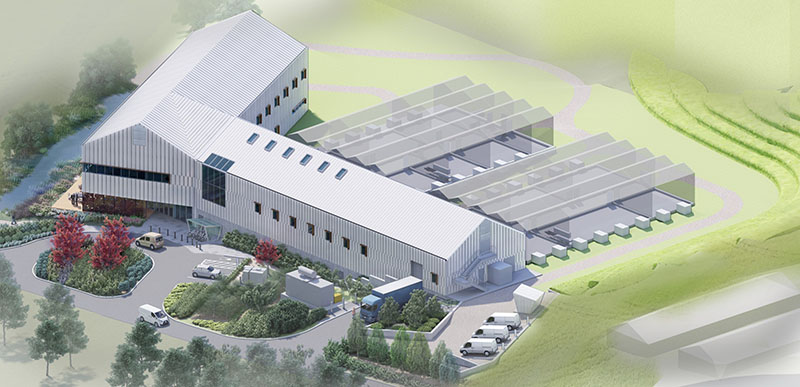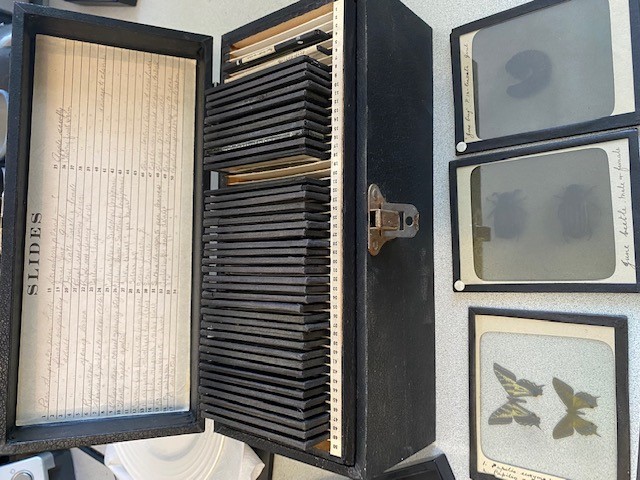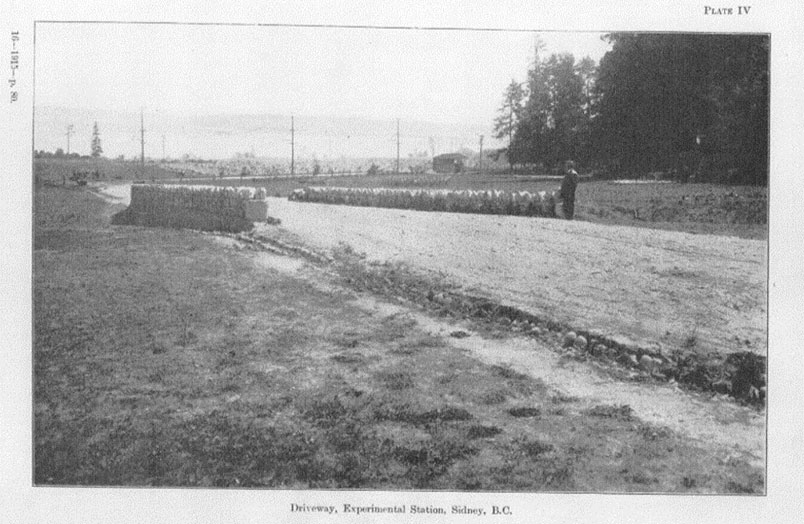
Building on more than 110 years of history, the Canadian Food Inspection Agency's (CFIA's) Sidney Laboratory – also known as the Centre for Plant Health – will soon be home to a brand new plant health science facility.
The Centre for Plant Health (CPH) is located on the Saanich peninsula on Vancouver Island, on the traditional territory of the W̱sáneć peoples. This includes the W̱jołełp (Tsartlip), the W̱sĺḵem (Tseycum), the SȾáutw̱ (Tsawout), the Boḱećen (Pauquachin) and the MálexeȽ (Malahat) First Nations. These are Coast Salish peoples who have lived on the land now known as the Saanich peninsula, and surrounding areas, for thousands of years.
Before construction of the new facility began, CPH enlisted the help of knowledgeable community volunteers to start sorting through records and artifacts dating back more than a century. The volunteers' findings are like a time capsule of the last several decades of agricultural and horticultural research in Canada, and offer a glimpse into the history of the region.
Since its establishment in 1912, the Centre has been known by many names: the Dominion Experimental Farm, the Saanichton Experimental Farm, the Saanichton Research and Plant Quarantine Station, the Centre for Plant Health, the Sidney Laboratory and even the "old experimental farm" by some long-time residents.
Traditional uses and connections to the land
Since time immemorial, Coast Salish peoples have been stewards of the land where the Centre now sits. The site overlooks the beautiful views of Bazan Bay, an area called Ḱelset (Kwol-sit) in the local Coast Salish dialect of Senćoŧen. Ḱelset translates to "bailing" in English, a reference to the area's importance as a safe harbour for canoes on seafaring journeys to trade and travel to neighbouring villages in Canada and the United States. It was and remains a place to gather foods like fish, sea urchins and seagull eggs.
Continue reading "Traditional uses and connections to the land"

The Coast Salish peoples' knowledge, skills and understanding of the natural environment allowed them to eat, build, heal and thrive. They were also the area's first botanists, protecting the natural environment and its biodiversity.
The land surrounding the Centre includes exceptionally rare Garry oak ecosystems. Garry oak are broadleaved deciduous trees whose adjacent meadows support the highest biodiversity of plants in Coastal British Columbia.
Coast Salish peoples managed these ecosystems with controlled burns to promote the growth of camas lilies – edible root crops that were an important staple food source. So important were the camas bulbs that the Victoria area was known as "Camosun" or a "place to gather camas". The management of these ecosystems enhanced the health of Garry oak meadows, providing more food for elk and deer and likely helping to control invasive insects, pests and diseases.
With the arrival of European settlers in the mid-1800s, land uses were changed, non-native species were introduced and Indigenous ways of life were disrupted. Much of the unique flora and fauna on the island was damaged.
Today, Garry oak ecosystems are one of the most endangered in Canada. Conservation organizations and Government departments are consulting with local First Nations to learn more about their traditional techniques to preserve these unique ecosystems, highlighting the continued importance and value of Indigenous knowledge in plant health science and the protection of our environment.
A brief history of the Centre
In 1911, the Government of Canada purchased the Veitch farm, 50 hectares on Vancouver Island's Saanich Peninsula, near Sidney, British Columbia. The land was purchased from the British Columbia Electric Railway Company for $500 per hectare to establish a new Dominion experimental station.
Continuing reading "A brief history"

The site would be used for agricultural research to support Canadian farmers, and became part of a system of experimental farms and stations that stretched across Canada. Research activities at the newly established site included:
- animal husbandry
- beekeeping
- soil science
- the production of various crops and flower bulbs
The following decades saw ground-breaking research in:
- hydroponics
- aeroponics
- solar heating for greenhouses

Eventually the site included a plant pathology and entomology laboratories, with a focus on ornamental and greenhouse crops.
In 1965, the Department of Agriculture established a post-entry quarantine station at the site to prevent the spread of diseases from plant material introduced into Canada. With its moderate climate and relative isolation from major commercial agriculture, the station was considered an ideal location for plant quarantine. This new role reinforced the site's national importance to plant health science. Today, the Centre for Plant Health remains Canada's only post-entry quarantine, research and diagnostic facility for imported horticultural plant material including fruit trees, grapevines and small fruits.
In the 1970s and 1980s, a partnership with industry and the British Columbia Ministry of Agriculture led to major developments in the production and use of biological control agents in greenhouses. Biological control agents are organisms used to control plant pests, for example, using parasitic wasps to control emerald ash borer, an invasive beetle. The facility has continued to evolve as diagnostic tests have advanced and new threats to plant health have emerged. The station became part of the CFIA's network of laboratories when the Agency was established in 1997 and was renamed the Centre for Plant Health.
Surprising finds
Linda Ball is one of the volunteers going through the records at the Centre for Plant Health. She's a former volunteer at the Sidney Museum, and her daughter, Patricia, currently works at the Centre for Plant Health.
Linda has also been going through the books and specimens to possibly include in the museum, and has come across many interesting items. "I have lived in Victoria and the Saanich Peninsula for over 80 years and was always aware of the Dominion Experimental Farm but was never really sure what they were experimenting on," Linda explains.
Continue reading "Suprising finds"

Linda was impressed by the precise records she came across, down to the cost of oats for the horses that cleared and plowed the land in the first years of operations. While going through records, Linda noticed several references to detections of golden nematode (Globodera rostochiensis) by scientists at what was then called the Saanichton Experimental Farm in 1965.
Linda remembers working at a farm stand in rural Saanich in the 1960s that mostly sold potatoes – that is, until the farmer she worked for suddenly switched to growing and selling carrots. "What fun it was working on the conveyer belt, washing and sorting carrots!" she recalled, fondly. Until she had gone through the archives at the Centre for Plant Health, Linda had never understood that the reason for the farmer's sudden change was because of recommendations from scientists at the Saanichton Experimental Farm. The farmer had stopped growing host crops vulnerable to golden nematode as part of the efforts to control and limit the spread of this pest.
Dominion Brook Park
The Centre for Plant Health's idyllic environment sloping down to the Salish Sea is a beautiful spot to enjoy nature and scenic views.
Dominion Brook Park sits on 4.5 hectares leased by the Government of Canada to the District of North Saanich at the northern end of the Centre for Plant Health property. The Park was established in 1912 as an arboretum and ornamental garden.
Continue reading "Dominion Brook Park"
One of the volunteers going through the Centre for Plant health archives is Jody Aylard, the Past President of the Friends of Dominion Brook Park Society. She has a keen interest in the history of the site as it relates to the Park.
The Society has uncovered archival records of orders and plantings from the Park's first years that show the scope and range of the specimens acquired. In October of 1913, the Dominion Experimental Farm ordered the entire range of 50 species of peony plants – two of each variety – from the Paeonia Moutan collection catalogue of the Yokohama Nursery in Japan. The Dominion Experimental Farm also ordered 148 different species from the renowned Arnold Arboretum of Harvard University in 1913. A number of plants are attributed to famous plant collectors of that era, including Ernest Wilson and William Purdom. "We still have specimens growing in the Park from the first plantings in 1913," Jody describes. "You can walk on the grounds and see some of the early work done in the Park – both structurally and in terms of plant specimens – from as far back as the first years of the experimental farm."
Image gallery
The railway era
At one time, there were rights of way for 3 railways running from Victoria through the Centre for Plant Health property. When the Centre was established, the Victoria and Sidney Railway had already been operating since 1894. In 1913, the British Columbia Electric Railway also opened a new line from Victoria to North Saanich. In the same year, construction started on a third railway, the Patricia Bay line of the Canadian Northern Pacific Railway.
Continue reading "The railway era"
All 3 lines ran through the property, each with its own station that brought large groups to Bazan Bay and Dominion Brook Park for family gatherings and holiday outings. By the 1920s, all 3 railways had ceased operations, but their paths through the site helped make Dominion Brook Park and the Centre for Plant Health important parts of the social history of the Saanich Peninsula. The British Columbia Electric Railway was the last passenger service to operate on the peninsula, and the Canadian Northern Pacific Railway Line eventually became Highway 17, or the Patricia Bay Highway.
When the British Columbia Electric Railway ceased operations in 1924, the Bazan Bay Station was moved a few hundred meters west into Dominion Brook Park and served as a tea house for over 30 years. In 1956, the original station was replaced with a new structure that now serves as a picnic shelter, and the Park continues to be a popular picnic spot for local residents and visitors. Built in 1929, the Pavilion at the Centre for Plant Health is still standing today, and has also been used as a community hall and hosted cultural activities for local residents for several decades. The oldest surviving building onsite, the former cattle barn and machine shop, was built in 1916 and is now a Recognized Federal Heritage Building.
A new chapter for the Centre for Plant Health
Upcoming work at the Centre for Plant Health will make it difficult for anyone to refer to the site as the "old experimental farm." A new facility will provide CFIA scientists and collaborators with state-of-the-art amenities and modernized tools to advance plant science while supporting Canadian agriculture, global trade and economic growth.
Most of the current buildings at the Centre are wood frame converted barns and homes built between 1912 and 1961. Having a new, built-for-purpose greenhouse and adjoining building with prep and lab space will improve efficiency and increase capacity for CFIA scientists. This will allow plant diseases to be detected faster and more accurately, which is key to keeping Canadian agri-business, trade and the environment safe. The facility will also provide added space for scientific collaboration with experts. This will advance research, priorities and initiatives in plant health science in Canada and internationally.
A site blessing ceremony held on September 21, 2022 reinforced the CFIA's commitment to honour local First Nations communities. Artists from local First Nations will incorporate Coast Salish stories into the design and artwork of the site and buildings, and plants used in landscaping will be native or locally adapted species that take inspiration from Indigenous stories and traditional uses. Representatives for the W̱sáneć peoples have also been overseeing the construction excavation work to help protect Indigenous interests and build relationships. Discussions are also underway to better understand how Indigenous science, knowledge and traditions can contribute to the Centre's ongoing work in plant health science.
The new facility will build upon the Centre for Plant Health's celebrated history and provide modern tools and infrastructure to support new generations of scientists to advance plant health science in Canada. This next chapter will continue to reinforce the Centre's importance to local communities and Canadians across the country.
Learn more
- Meet Tracy Lawrence, CFIA virology technician
- Collaborating with genome specialists to protect Canadian wine
- Podcast with Anna-Mary Schmidt, Head of Grapevine Diagnostics
- Making grapes into wine – it's di-vine!
- News release: Government of Canada invests $80 million in the Centre for Plant Health
- Sidney Laboratory, Centre for Plant Health. In: Plant Pathology in Canada 1970-2008 [researchgate.net]
Get more Inspect and Protect
- Want to learn more about what we do? Explore articles, videos and podcasts.
- Interested in reporting on a story? Contact CFIA Media Relations to arrange an interview with one of our experts.
- Have an idea or feedback to share? Get in touch!







